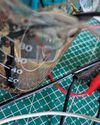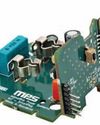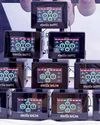Six Most Important Lithium-ion Battery Chemistries
Electronics For You
|September 2022
Li-ion cell is one of the most important energy storage devices in today’s time. The cell has a lot of different chemistries, and the properties of these cells depend on their internal chemistry. Every single chemistry has its own pros and cons

Lithium-ion (Li-ion) cells provide one of the most important energy storages today. These cells are used in many electronic items including smartphones, laptops, personal portable equipment, cameras, etc. In fact, Li-ion cells have paved the way for efficient and long ranged electromobility, thus making electrical vehicles (EVs) practical for our daily commute.
Li-ion cells are secondary cells or, in other words, rechargeable cells, that is, they can be recharged by passing current in the reverse direction. Li-ion batteries are lightweight and have higher energy density than other types of rechargeable cells, thus making them suitable for energy-intensive applications where constant replenishment of energy is essential, such as in our daily electronics gadgets, EVs, home energy storage system. These are used even in applications where a large amount of energy is stored, such as grid energy storage application.
This article describes the six most common Li-ion chemistries and the advantages as well as disadvantages of each type of cell, along with their properties.
Like many other commonly available cells, Li-ion cells are made up of four components— cathode, anode, electrolyte, and separator. Li-ion cells commonly use graphite at anode and an intercalated lithium compound at cathode. The capacity and voltage of a Li-ion cell is dependent on the cathode while the charge and discharge rate of a battery depends on the anode. The amount of lithium and the active material in the cathode dictates the battery capacity and voltage while the potential difference between the anode and the cathode determines the voltage of a battery.
Esta historia es de la edición September 2022 de Electronics For You.
Suscríbete a Magzter GOLD para acceder a miles de historias premium seleccionadas y a más de 9000 revistas y periódicos.
¿Ya eres suscriptor? Iniciar sesión
MÁS HISTORIAS DE Electronics For You

Electronics For You
Tech Majors Are Racing TOWARDS NET-ZERO - What About You?
Apple, Microsoft, Amazon, Google, Infosys, Wipro—global and Indian firms are heading closer to achieving net-zero emissions, a mandate to combat climate change. Here is what you need to know to start your journey...
12 mins
December 2025

Electronics For You
Miniature IoT WATER TDS And LEVEL MONITOR Cum CONTROLLER
For setups that rely on stored water, clear awareness of tank level and water quality is essential.
3 mins
December 2025

Electronics For You
The Impact Of GENERATIVE AI On The Future Of AUTOMOTIVE AND EVs
Autonomous vehicles, connected ecosystems, and smart factories are only the beginning. Generative Al is pushing the auto industry beyond predictions into a bold era of creativity-from EV design to real-time diagnostics and showroom automation. Here is how GenAl is reshaping innovation across the automotive value chain.
8 mins
December 2025

Electronics For You
How AI Tools Are Making SOFTWARE DEVELOPMENT BETTER
AI is reshaping how we code, debug, and collaborate. From Copilot to automation, it is changing software development in ways worth exploring.
3 mins
December 2025
Electronics For You
How AI Tools Are Making SOFTWARE DEVELOPMENT BETTER
AI is reshaping how we code, debug, and collaborate. From Copilot to automation, it is changing software development in ways worth exploring.
3 mins
December 2025

Electronics For You
5 Interesting Reference Designs FOR SMART HOMES
Smart home devices are transforming the way people interact with their appliances. They make homes more convenient, secure, and energy-efficient. From smart plugs and energy monitors to smart locks and thermostats, reference designs help design engineers create connected products that are easy to use, consume less power, and are reliable. These designs allow you to control devices remotely, track energy use, extend battery life, and automate routines. They provide practical solutions for upgrading homes and small commercial spaces without major modifications.
3 mins
December 2025

Electronics For You
Fancy USB LED VASE
This USB LED vase is a simple yet elegant device that fuses art with electronics to create a decorative lighting display. Powered directly from a standard USB port, it uses readily available components such as MOSFETs, resistors, capacitors, and LEDs to produce a striking, dynamic sequence of lights.
3 mins
December 2025

Electronics For You
"WHAT OTHERS SELL IN FOUR BOXES WE BUILT IN ONE"
Years of custom field work are shaping a product line with its own cloud, its own hardware, and a market that is now beginning to recognise its value.
8 mins
December 2025

Electronics For You
BUILD LARGE LANGUAGE MODELS
Large language models are machine learning models designed for a range of language-related tasks such as text generation and translation. Here’s how open source software can help you build your own large language model.
6 mins
December 2025

Electronics For You
Rare Earth Or Rare Ingenuity? India Remains Between The Two
With China firmly controlling rare earth exports, India confronts a critical moment in its technological trajectory.
8 mins
December 2025
Translate
Change font size

